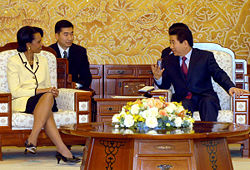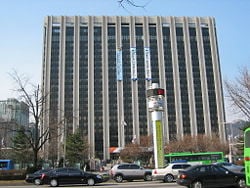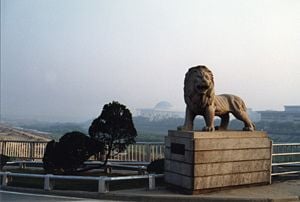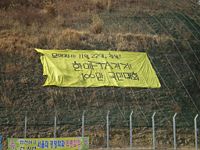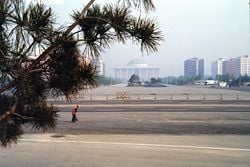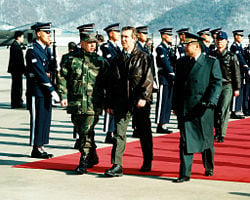Government of South Korea
| South Korea |
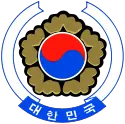 This article is part of the series: |
|
|
| Government |
|---|
|
Sixth Republic |
|
President Prime Minister Ministries |
|
National Assembly |
|
Supreme Court |
| Others |
|
Korean reunification |
The government of South Korea is the latest fruit of a long development of governments in Korea. Enjoying the development as a nation over at least a 2,000 year period, South Korea has roots in the Three Kingdom period, Unified Silla Dynasty, Goreyo Dynasty, Joseon Dynasty, Japanese colonial era, and the most recent Republic of South Korea. The influences of Buddhism, Confucianism, and Christianity have been to most pronounced upon the development of democracy in South Korea. Having faced a determined communist dictatorship in the North, South Korea has still managed to create one of the most vibrant democratic communities in the world.
The government of South Korea divides into three branches: executive, judicial, and legislative. The executive and judicial branches operate primarily at the national level, although various ministries in the executive branch also carry out local functions. Local governments operate semi-autonomously, and contain executive and legislative bodies of their own. The judicial branch operates at both the national and local levels.
The Constitution of the Republic of Korea determines the structure of the South Korean government. The Constitution has been revised several times since its first promulgation in 1948 (for details, see History of South Korea), yet retains many broad characteristics. The country has always had a presidential system with a relatively independent chief executive, with the exception of the short-lived Second Republic of South Korea. A careful system of checks and balances maintains the stability of the three-branches of government. For instance, the executive and the legislature both have a say in appointing the judges of the Constitutional Court. Likewise, when the legislature passes a resolution of impeachment, the judiciary makes the final decision.
Executive branch
The president heads the executive branch. The people elect the president directly, the only elected member of the national executive branch. The Constitution permits the president one five-year term. The president serves as head of government, head of state, and commander in chief of the South Korean armed forces, vested with the power to declare war, and can also propose legislation to the National Assembly. He has the authority to declare a state of emergency or martial law, subject to the Assembly's subsequent approval. The president lacks the power to dissolve the National Assembly. That safeguard reflects the experience of totalitarian governments under the First, Third, and Fourth Republics.
The National Assembly has the vested authority to initiate impeachment proceedings in the event of suspected serious wrongdoing by the president or cabinet-level officials. The Constitutional Court decides impeachment cases. The Prime Minister of South Korea, appointed by the president and approved by the National Assembly, assists the president in his duties. In the event that the president become incapacitated, the Prime Minister takes control of the state. The Prime Minister has the power to recommend the appointment or dismissal of cabinet ministers.
State Council
The president, Prime Minister, and cabinet-level ministers comprise the State Council. Those ministers represent the eighteen ministries of the South Korean government. The Constitution charges the Council with deliberating on major policy decisions; the president chairs the meetings which the Prime Minister officiates. Although the Council lacks the power to make final decisions, the Constitution requires that the Council hear certain matters. Those include bestowals of state honors, drafts of constitutional amendments, declarations of war, budget proposals, government restructurings, and emergency orders.
Ministries
The president appoints the heads of the ministries. The ministers report to the Prime Minister.
- Ministry of Agriculture and Forestry (농림부, 農林部)
- Ministry of Commerce, Industry and Energy (산업자원부, 産業資源部)
- Ministry of Construction and Transportation (건설교통부, 建設交通部)
- Ministry of Culture and Tourism (문화관광부, 文化觀光部)
- Ministry of Education and Human Resource Development (교육인적자원부, 敎育人的資源部) - One of the Vice Prime Minister
- Ministry of Environment (환경부, 環境部)
- Ministry of Finance and Economy (재정경제부, 財政經濟部) - One of the Vice Prime Minister
- Ministry of Foreign Affairs and Trade (외교통상부, 外交通商部)
- Ministry of Gender Equality and Family (여성가족부, 女性家族部)
- Ministry of Government Administration and Home Affairs (행정자치부, 行政自治部)
- Ministry of Health and Welfare (보건복지부, 保健福祉部)
- Ministry of Information and Communication (정보통신부, 情報通信部)
- Ministry of Justice (법무부, 法務部)
- Ministry of Labor (노동부, 勞動部)
- Ministry of Maritime Affairs and Fisheries (해양수산부, 海洋水産部)
- Ministry of National Defense (국방부, 國防部)
- Ministry of Planning and Budget (기획예산처, 企劃豫算處)
- Ministry of Science and Technology (과학기술부, 科學技術部) - One of the Vice Prime Minister
- Ministry of Unification (통일부, 統一部)
Independent agencies
Many of these agencies are managed by intermediate agencies; others report directly to the Prime Minister or to the President.
The following agencies report directly to the President:
- National Security Council
- Advisory Council on Democratic and Peaceful Unification
- Presidential Council on Science and Technology
- Presidential Commission on Small and Medium Business
- Civil Service Commission
- Korea Independent Commission Against Corruption
- Truth Commission on Suspicious Deaths
- Board of Audit and Inspection—the chairperson of this board, charged with general administrative oversight, must be approved by the National Assembly.
- National Intelligence Service
Several offices report directly to the Prime Minister, including the Government Information Agency and the Fair Trade Commission. In addition, the following agencies report jointly to the Prime Minister and the head of their associated ministry:
- National Tax Service
- National Statistical Office
- Supreme Public Prosecutor
- Military Manpower Administration
- National Police Agency
- Korea Meteorological Administration
- Cultural Properties Administration
- Rural Development Administration
- Korea Forest Service
- Small and Medium Business Administration
- Korean Intellectual Property Office
- Korea Food and Drug Administration
- National Maritime Police Agency
- Korean National Youth Commission
Legislative branch
At the national level, the legislative branch consists of the National Assembly of South Korea. A unicameral legislature, a single large assembly of 273 members. Single-member constituencies elect most the legislatures, although 46 are elected through proportional representation. The members of the National Assembly serve for four years. In the event that a member becomes unable to complete his or her term, by-election replaces them. The Constitution charges the National Assembly with deliberating and passing legislation, auditing the budget and administrative procedures, ratifying treaties, and approving state appointments. The National Assembly also has the power to impeach or recommend the removal of high officials.
The Assembly forms seventeen standing committees to deliberate matters of detailed policy. For the most part, those coincide with the ministries of the executive branch. Bills pass through those committees before they reach the floor. Before they reach committee, they must have already gained the support of at least twenty members, unless they have been introduced by the president. To secure final passage, a bill must receive a majority vote from those present; a tie vote fails. After passage, the legislature sends the bills to the president for approval; he must approve them within 15 days.
Each year, the executive submits the budget to the National Assembly. By law, the executive must submit the bill at least 90 days before the start of the fiscal year, the final version must win approval at least 30 days before the start of the fiscal year. The Assembly has the responsibility to audit accounts of past expenditures, which must be submitted at least 120 days before the start of the fiscal year. Sessions of the Assembly may be held regularly (once a year, for no more than 100 days) or extraordinarily (by request of the president or a caucus, no more than 30 days). By default, the Assembly holds open-door sessions. The session can be closed to the public by majority vote or by decree of the Speaker. A quorum of half the members must be present in any session to pass laws. Currently, five political parties of South Korea have representation in the National Assembly.
Judicial branch
The Constitutional Court heads the judicial branch, a system newly established in the Sixth Republic to help guard against the excesses of past regimes. The Constitutional Court consists of nine justices. The Chief Justice of the Supreme Court, the National Assembly, and the president each recommend three. The president makes the appointments official. The national president appoints the President of the Constitutional Court, subject to the approval of the National Assembly. The members of the court serve for six-year renewable terms until the age of 65 (70 years old in the case of the President of the court).
The Constitutional Court conducts constitutional review and rules on cases of impeachment. The Supreme Court oversees other judicial matters, the final court of appeal for all cases in South Korean law. The Supreme Court, seated in Seoul, consists of 14 Justices, including one Chief Justice. The Justices must be 40 years or older, and have at least 15 years of experience practicing law. The Constitution restricts the Chief Justice to one term while the other justices may receive multiple appointments.
Below the Supreme Court come appellate courts, stationed in five of the country's major cities. Appellate courts typically consist of a panel of three judges. District courts, which exist in most of the large cities of South Korea, come below those followed by branch and municipal courts, positioned all over the country and limited to small claims and petty offenses. Specialized courts hear family, administrative, and patent cases. The national judiciary adjudicate all courts; the Constitution prohibits independent courts. Judges throughout the system must pass a rigorous training system including a two-year program and two-year apprenticeship. The Judicial Research and Training Institute conducts all judicial training; only those who have passed the National Judicial Examination may receive appointments. The Chief Justice of the Supreme Court has the power over all court administration, and can recommend court-related legislation to the National Assembly.
Local government
First Republic established Local autonomy as a constitutional principle of South Korea. For much of the twentieth century that principle has been dishonored. From 1965 to 1995, provincial governments, run directly by the national government, ran local governments. Since the elections of 1995, a degree of local autonomy has been restored. In each of the primary and secondary administrative divisions of South Korea, that is, in every province, metropolitan or special city, and district, local magistrates and assemblies run for election. City or county governments appoint officials at lower levels, such as eup and dong. As noted above, the judicial branch enjoys freedom from local autonomy. Independent national agencies manage many other areas, including fire protection and education. Local governments also have extremely limited policy-making authority, usually limited to the implementation of national policies. Recently, local governments have been pressing for more authority on the local level.
The central government appoints deputy executives, while popular local elections determine the chief executive. Deputy officials have authority over the details of most administrative matters.
Civil service
Although efforts at openness and reform have been ongoing, the large South Korean civil service remains a largely closed system. Candidates for civil service positions unusually have to pass one or more difficult examinations. Although positions traditionally had been handed out based on seniority, in a complex graded system, reforms in 1998 substantially eliminated that policy.
More than 800,000 civil servants work in South Korea today, half employed by the central government while local governments employ only about 300,000. With on a few thousand employed by the national legislative and judicial branches, the various ministries of the executive branch employ the overwhelming majority. The size of the civil service increased steadily from the 1950s to the late 1990s, but has dropped slightly since 1995.
Career civil servants and contract civil servants, with the exception of political appointees and elected officials comprise the civil service. Contract servants typically receive higher wages for specific jobs. Career civil servants make up the bulk of the civil service, arranged in a nine-tiered system in which assistant ministers occupy grade one and the newest and lowest-level employees grade nine. A combination of seniority, training, and performance review determines promotions. Civil servants' base salary makes up less than half of their annual pay; a complex system of bonuses determines the remainder. Contract civil servants receive pay based on competitive rates of pay in the private sector.
Elections
Elections are overseen by the National Election Commission of South Korea.
ReferencesISBN links support NWE through referral fees
- Bedeski, Robert E. 1994. The transformation of South Korea: reform and reconstitution in the sixth republic under Roh Tae Woo, 1987-1992. London: Routledge. ISBN 9780415057509
- Breen, Michael. 1999. The Koreans: who they are, what they want, where their future lies. New York: St. Martin's Press. ISBN 9780312242114
- Kil, Sŭng-hŭm, and Chung-in Moon. 2001. Understanding Korean politics: an introduction. SUNY series in Korean studies. Albany: State University of New York Press. ISBN 9780791448892
- Korea Overseas Information Service (2003). Handbook of Korea, 11th ed.. Seoul: Hollym. ISBN 1-56591-212-8.
- Macdonald, Donald Stone. 1988. The Koreans: contemporary politics and society. Boulder: Westview Press.ISBN 9780813305158
External links
All links retrieved July 8, 2017.
- Ministry of Agriculture and Forestry
- Ministry of Gender Equality and Family
- Ministry of Justice
- Ministry of National Defense
- Ministry of Unification
- National Assembly of the Republic of Korea
- Overseas Information Agency of the Republic of Korea
Credits
New World Encyclopedia writers and editors rewrote and completed the Wikipedia article in accordance with New World Encyclopedia standards. This article abides by terms of the Creative Commons CC-by-sa 3.0 License (CC-by-sa), which may be used and disseminated with proper attribution. Credit is due under the terms of this license that can reference both the New World Encyclopedia contributors and the selfless volunteer contributors of the Wikimedia Foundation. To cite this article click here for a list of acceptable citing formats.The history of earlier contributions by wikipedians is accessible to researchers here:
The history of this article since it was imported to New World Encyclopedia:
Note: Some restrictions may apply to use of individual images which are separately licensed.
